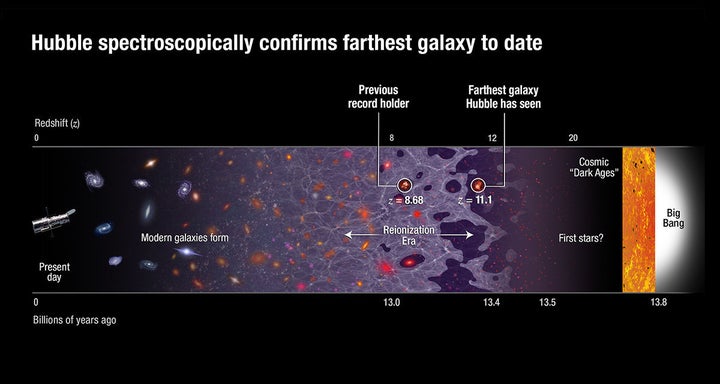The Hubble Space Telescope has been “pushed to its limits,” and the result is a total shocker.
On Friday, NASA announced that the telescope had seen farther back in time than ever before, successfully observing the most distant (and oldest) galaxy in the universe to date.
The galaxy, dubbed GN-z11, is located a record 13.4 billion light years from Earth -- that’s just 400 million years after the Big Bang -- in the direction of the constellation Ursa Major. (In case you need an astronomy refresher, distance and age are linked here. The farther away an object is from Earth, the more time it takes for its light to reach us.)
“We’ve taken a major step back in time, beyond what we’d ever expected to be able to do with Hubble,” said Yale University astronomer Pascal Oesch in a news release. “We see GN-z11 at a time when the universe was only three percent of its current age.”
The previous record-holder for the most distant galaxy was known as EGS8p7, located some 13.24 billion light years from Earth, or 573 million years after the Big Bang.

Just how do astronomers measure such large distances?
Due to an expanding universe, distant objects appear to be moving away from Earth as its light is stretched to longer, redder wavelengths, a phenomenon known as “cosmological redshift.” Determining a galaxy's redshift can indicate its distance away from Earth.
“The greater the redshift, the farther the galaxy,” NASA explained.
The space agency said the telescope's latest finding revealed “surprising new clues” about the beginnings of our universe.
“This discovery pushes back the frontier of our knowledge regarding the earliest phases of the universe and advances our quest to witness cosmic dawn,” Patrick McCarthy, interim president of the Giant Magellan Telescope Organization, told Mashable. “Clear evidence that stars and galaxies formed soon after the Big Bang will challenge competing theories regarding the formation of the modern universe.”
NASA said it expects to find even older galaxies with the help of the James Webb Space Telescope, due to launch in 2018.
“This new discovery shows that the Webb telescope will surely find many such young galaxies reaching back to when the first galaxies were forming,” astronomer Garth Illingworth of the University of California, Santa Cruz, said in the release.
